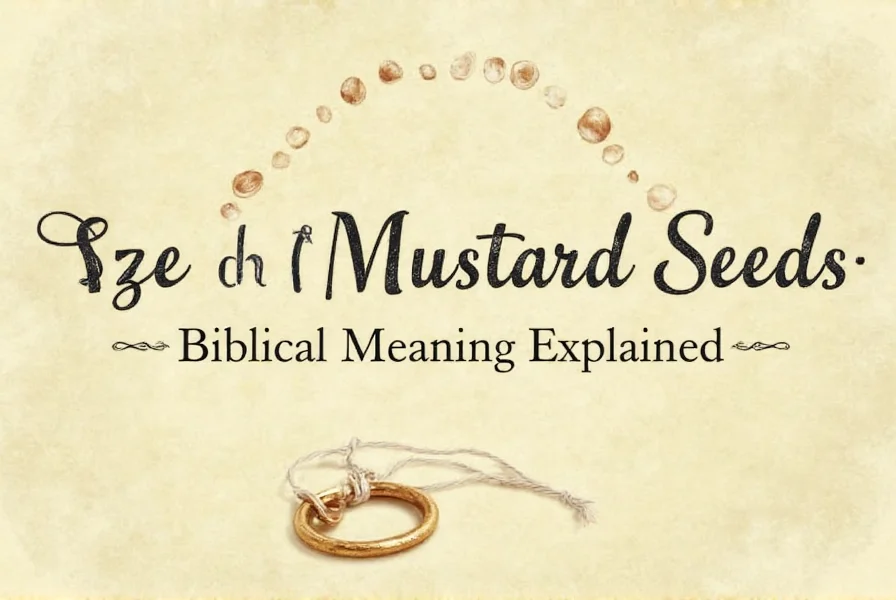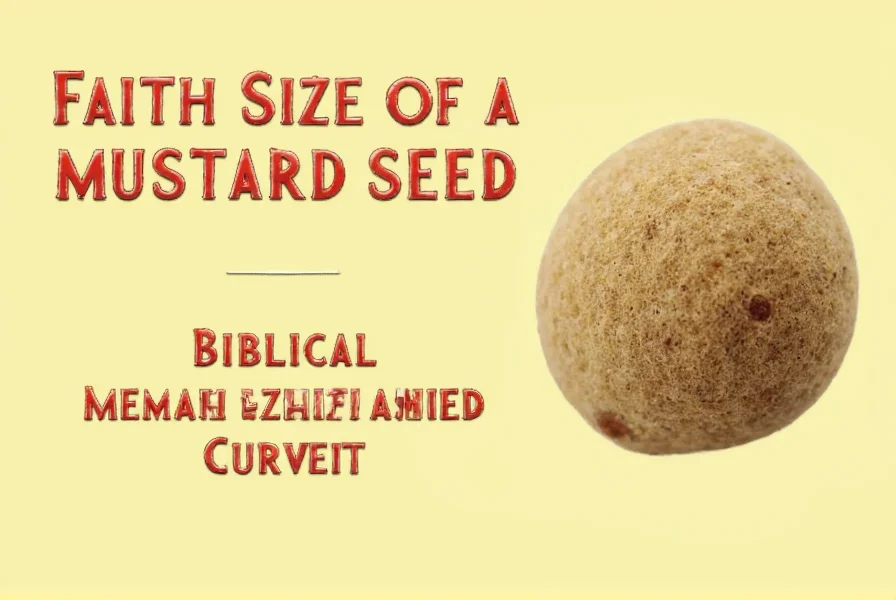When Jesus told His disciples they could move mountains with faith "as small as a mustard seed," He wasn't prescribing a specific measurement of belief. This powerful metaphor appears in both Matthew 17:20 and Luke 17:6, forming one of Christianity's most enduring teachings about the nature of authentic faith. Understanding this concept requires examining its historical context, botanical significance, and practical application for believers today.
The Biblical Context of Mustard Seed Faith
In the Gospel accounts, Jesus made this statement after His disciples failed to heal a demon-possessed boy. Their frustration led to His explanation: "Because of your little faith. For truly, I say to you, if you have faith like a grain of mustard seed, you will say to this mountain, 'Move from here to there,' and it will move, and nothing will be impossible for you" (Matthew 17:20).
The mustard seed reference would have resonated deeply with Jesus' audience. In first-century Palestine, the black mustard plant (Salvadora persica) was common, known for its tiny seeds (1-2mm in diameter) that grew into substantial shrubs reaching 6-8 feet tall. This contrast between minuscule beginning and significant outcome perfectly illustrated Jesus' point about faith's potential.
| Biblical Reference | Exact Quote | Context |
|---|---|---|
| Matthew 17:20 | "Truly I tell you, if you have faith as small as a mustard seed..." | After disciples failed to heal a demon-possessed boy |
| Luke 17:6 | "If you have faith as small as a mustard seed..." | Teaching on forgiveness and faith |
What Jesus Meant by This Teaching
The mustard seed metaphor addresses three critical aspects of faith:
- Quality over quantity - Jesus emphasized that effective faith isn't measured by intensity or emotional experience but by its object (God's power)
- Dependence on God's power - The mountain-moving imagery points to divine capability, not human effort
- Active trust - Biblical faith involves reliance and obedience, not merely intellectual assent
Many misinterpret this teaching as suggesting that believers must generate enormous faith. However, Jesus' point was precisely the opposite: even the smallest authentic faith, when directed toward God, accesses His unlimited power. The mustard seed's significance lies not in its size but in its potential when planted in proper soil.

Common Misconceptions About Mustard Seed Faith
Several misunderstandings have developed around this teaching:
- The prosperity gospel distortion - Some claim this verse guarantees material blessings for sufficient faith, ignoring the biblical context of spiritual warfare and discipleship
- Quantification fallacy - Believers often measure faith by emotional intensity rather than trust in God's character
- Isolated application - This teaching appears within Jesus' broader instruction on prayer, fasting, and dependence on God (Matthew 17:21)
Understanding the mustard seed metaphor requires recognizing that Jesus contrasted the disciples' "little faith" (oligopistia) with genuine trust. Their problem wasn't insufficient emotional conviction but misplaced confidence—in their own abilities rather than God's power.
Practical Application for Modern Believers
How does this ancient teaching apply to contemporary challenges? Consider these practical implications:
When facing seemingly insurmountable obstacles—whether personal struggles, relational conflicts, or spiritual battles—the mustard seed principle reminds us that God honors even the smallest authentic trust. The key isn't mustering greater emotional certainty but redirecting our dependence to God's faithfulness.
For those experiencing doubt or spiritual dryness, this teaching offers profound encouragement. You don't need dramatic religious experiences; you need only the smallest seed of trust in God's character. Like the father in Mark 9:24 who cried, "I believe; help my unbelief!", authentic faith often coexists with uncertainty.
Mustard Seed Faith in Biblical Theology
This teaching fits within Scripture's broader theology of faith:
- Hebrews 11 defines faith as "the assurance of things hoped for, the conviction of things not seen"
- Ephesians 2:8 clarifies that faith itself is "a gift of God"
- James 2 emphasizes that genuine faith produces action
The mustard seed metaphor beautifully illustrates that biblical faith isn't self-generated confidence but reliance on God's promises. Like the tiny seed that grows into a substantial plant, authentic faith develops through continued dependence on God, not through human effort to increase its size.
Conclusion: The Power of Authentic Trust
The enduring power of Jesus' mustard seed teaching lies in its invitation to trust God's character rather than measure our belief. When we understand that faith's effectiveness comes from its object (God) rather than its quantity, we're freed from performance-based spirituality.
Whether you're facing personal challenges, spiritual dryness, or seemingly impossible circumstances, remember that God honors even the smallest seed of trust. The mustard seed's journey from invisibility to substantial growth mirrors how authentic faith operates in the believer's life—not through human effort, but through divine power working through simple trust.
What does 'faith the size of a mustard seed' actually mean biblically?
Biblically, 'faith the size of a mustard seed' means that even a small amount of genuine trust in God's power can accomplish what seems impossible. Jesus used this metaphor to teach that faith's effectiveness depends on its object (God) rather than its quantity. The mustard seed, one of the smallest seeds in Jesus' time, represented how authentic faith—no matter how small—can grow into something significant when rooted in God's power.
Where in the Bible is the mustard seed faith mentioned?
The mustard seed faith teaching appears in two Gospel accounts: Matthew 17:20 and Luke 17:6. In Matthew, Jesus says this after His disciples failed to heal a demon-possessed boy, explaining that even faith 'as small as a mustard seed' could move mountains. In Luke, He uses the same metaphor while teaching about forgiveness and faith.
Does mustard seed faith guarantee that prayers will be answered?
Mustard seed faith doesn't guarantee specific outcomes but emphasizes trusting God's power and sovereignty. The mountain-moving imagery represents accessing God's power through faith, not manipulating God to fulfill human desires. Biblical faith always submits to God's will (Matthew 6:10), recognizing that His purposes may differ from our requests. True mustard seed faith trusts God's character even when prayers aren't answered as expected.
How can I develop mustard seed faith when I'm struggling with doubt?
Developing mustard seed faith amid doubt begins with acknowledging your uncertainty while choosing to trust God anyway. Like the father in Mark 9:24 who said, 'I believe; help my unbelief!', authentic faith often coexists with questions. Focus on God's character rather than your emotional state, engage with Scripture, connect with faithful community, and take small steps of obedience. Remember that faith is a gift from God (Ephesians 2:8), not something you must manufacture through sheer willpower.











 浙公网安备
33010002000092号
浙公网安备
33010002000092号 浙B2-20120091-4
浙B2-20120091-4